This article is published in the White Paper category.
In Korea, there is an old tradition from the Joseon dynasty where markets are held every 5 days for groups of merchants to gather at a particular location to sell or trade goods.
These markets were extremely important for the city economy, not only attracting the local people but also people from the outside of the city. Thus, they had vital roles to enhance the economic activity of the city.
Today, five-day markets are the perfect place for tourists to experience the traditional Korean lifestyle, where people find local goods including fresh harvests as well as homemade products and their popular street foods. While the market brings a significant contribution to the city, it is important that we have accurate data that demonstrates the value of markets.
While measuring the impact of five-day markets on the city economy, we need to check two types of contributions.
First is the direct contribution, which is the average amount of money people spend on the market multiplied by the number of visitors.
Second is the indirect contribution – the average amount of money spent by people visiting the market outside of the market area. This contribution is generated from visitors who visit the market and continue their shopping outside of the market area.
In addition to the positive impact of the market on the city, it is also necessary to measure the negative impact of the market on the economy. This impact is created by shifting visitors from other areas of the city to the market.
By using a crowd analytics system it is possible to measure the three factors of the economic valuation:
The direct contribution of the market is measured by the number of people visiting the market area compared to the number of visitors in a regular day.

The indirect contribution is measured by the mobility patterns of the market, i.e. how many people went from the market to visit other areas.

And finally, the negative impact of the market is measured by comparing the actual number of visitors in other areas of the city compared to the expected number of visitors without the market.

Do you want to know more about our smart city valuation? Contact us to know more.

Data team
Copyright © 2022 DFRC
43 Science Park Road #01-11 Rm 8, Singapore 117408